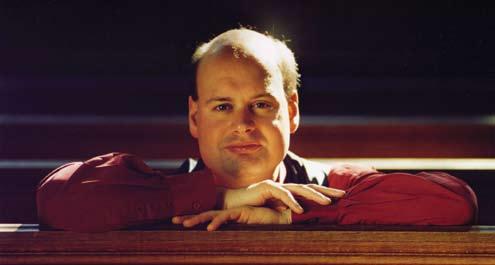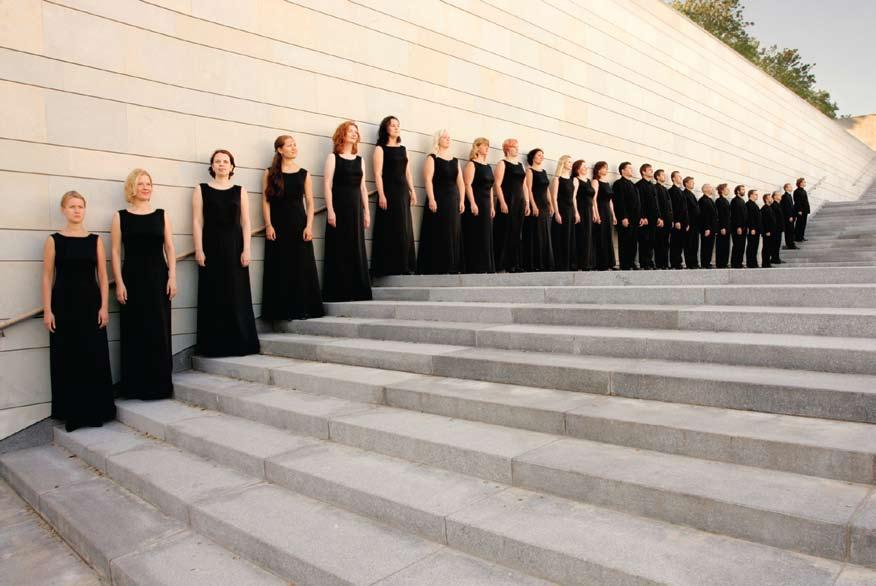愛沙尼亞愛樂室樂合唱團
Estonian Philharmonic Chamber Choir
愛沙尼亞愛樂室樂合唱團是愛沙尼亞 知名的專業樂團。東努.卡尤斯特 在1981年創立樂團,並擔任藝術總 監兼首席指揮達20年之久;2001到 2007年由英國音樂家保羅.希利亞接 棒;2008年9月起,藝術總監兼指揮 一職由丹尼爾.若斯擔任。
合唱團能古能今,曲目涵蓋格雷果聖 咏到二十世紀的作品,樂團與愛沙尼 亞作曲家托米斯和帕特合作無間,他 倆的作品在合唱團的曲目中倍受重 視。合唱團定期在歐洲,美加和日本 巡迴演出。
合唱團曾與多位知名指揮家和樂團合 作,包括亞巴度、約菲、玻爾、澳洲 室樂團、以色列愛樂樂團、布拉格室 樂團、哥本哈根古樂協奏團、德國室 樂愛樂樂團、塔林室樂團和愛沙尼亞 國立交響樂團;曾獲邀到多個著名國 際音樂節演出,計有英國廣播公司逍 遙音樂會、愛丁堡藝術節、薩爾茨堡 藝術節等。
合唱團的唱片曾贏取多個獎項,包括 2007年憑帕特的《平安》獲格林美最 佳合唱演出獎、《波羅的海之聲第三 輯》拿了金音叉唱片獎和2006年的德 國唱片大獎。
加料節目 FESTivAl PluS
26.2.2009 (四) 上午11:30- 下午1:30
公開排練
香港教育學院C-LP-11演講廳
英語主講
憑柬入場
合辦:香港教育學院體藝學系(音樂部)
詳情請參閱藝術節加料節目指南,或瀏覽藝術節 網站:www.hk.artsfestival.org
The Estonian Philharmonic Chamber Choir (EPCC) has become Estonia’s best-known professional music group. The EPCC was founded in 1981 by Tõnu Kaljuste, who remained Artistic Director and Chief Conductor for 20 years. Between 2001-07 British musician Paul Hillier took up the posts. Daniel Reuss was appointed to the positions in September 2008.
The choir’s repertoire ranges from Gregorian Chant to 20th-century pieces and is recognized for its close relationship with Estonian composers Veljo Tormis and Arvo Pärt, whose music shares a very special place in the EPCC’s repertoire. The EPCC tours regularly in Europe, the US, Canada and Japan.
The EPCC has worked with celebrated conductors and orchestras including Claudio Abbado, Neeme Järvi, Roland Böer, Australian Chamber Orchestra, Israel Philharmonic Orchestra, Prague Chamber Orchestra, Concerto Copenhagen, Deutsche Kammerphilharmonie, Tallinn Chamber Orchestra and Estonian National Symphony Orchestra. It has been invited to participate in many famous international music festivals including BBC Proms, Edinburgh International Festival and Salzburg Festival.
The EPCC’s recordings have won several prizes including the Grammy award for the Best Choral Performance in 2007 for the recording of Arvo Pärt’s Da Pacem. Baltic Voices 3 was awarded the Diapason d’Or prize and the Preis der Deutschen Schallplatten (2006).

26.2.2009 (Thu) 11:30am-1:30pm Open Rehearsal C-LP-11 Lecture Theatre, Hong Kong Institute of Education
Conducted in English By invitation only
Co-presented with Department of Creative Arts & Physical Education (Music Division), The Hong Kong Institute of Education
For details please refer to the Festival Plus Booklet or go to the Festival website: www.hk.artsfestival.org

史提芬.萊頓
指揮 Conductor

Stephen Layton
憑着出眾的個人音樂造詣及令人眼前 一亮的流暢演出,史提芬.萊頓近年 成為英國炙手可熱的指揮家;由悉尼 歌劇院到阿姆斯特丹皇家音樂廳,都 可聽到他演繹的巴赫和韓德爾;與他 合作的樂團有古樂合奏團、啟蒙時代 樂團、英國國家歌劇團、倫敦愛樂和 費城交響樂團。
萊頓曾任荷蘭室樂合唱團首席指揮, 現身兼丹麥電台合唱團的首席客席指 揮、複音合唱團的總監、霍爾斯特合 唱團藝術總監、劍橋聖三一學院音樂
總監;他亦擔任各大國際知名樂團的 客席指揮,包括倫敦愛樂樂團、蘇格 蘭室樂團、伯恩茅斯交響樂團、阿爾 斯特樂團;又曾在英國國家歌劇團指 揮黛博拉.華納執導的巴赫《聖約翰 受難曲》。萊頓與布列頓小交響樂團 合作無間,灌錄了各類曲目,包括韓 德爾、布魯克納、浦朗克和史達拉汶 斯基的作品。
2001年萊頓替海帕里昂唱片公司製作 布列頓作品專輯,贏得了《留聲機》 雜誌大獎,並獲法國金音叉唱片獎的 年度最佳合唱唱片;此外,萊頓憑 兩張分別收錄韋達卡和羅里特森作品 的唱片,獲提名2006及2007年格林 美獎。
With a strikingly individual musicianship and a galvanising eloquence in performance Stephen Layton has established himself in recent years as one of Britain's most admired conductors. His interpretations of Bach and Handel have been heard from the Sydney Opera House to the Concertgebouw, and with orchestras that include the Academy of Ancient Music and the Orchestra of the Age of Enlightenment, as well as the English National Opera, London Philharmonic and the Philadelphia Orchestra.
A former Chief Conductor of the Netherlands Chamber Choir, Layton now holds the positions of Chief Guest Conductor of the Danish Radio Choir, Director of Polyphony, Artistic Director of the Holst Singers and Director of Music at Trinity College Cambridge. He works widely as a guest conductor of orchestras of international renown, including the London Philharmonic Orchestra, Scottish Chamber Orchestra, Bournemouth Symphony, Ulster Orchestra and English National Opera, where he conducted Deborah Warner’s renowned staging of Bach’s St John Passion. Layton has a close relationship with the Britten Sinfonia with whom he records a wide range of repertoire, including Handel, Bruckner, Poulenc and Stravinsky.
In 2001 Layton’s Hyperion recording of music by Britten received a Gramophone Award and the Diapason d’Or in France for best choral disc of the year. In the US, Stephen was nominated for Grammy Awards in both 2006 and 2007 for his Hyperion recordings of Whitacre and Lauridsen respectively.
帕特 (1935- )

2009年2月26日(星期四 )
孟德爾頌 (1809-1847)
《歡欣,童貞女》
《勝利之後》
《西緬頌》
《外邦為什麼爭鬧?》作品78,第1首
《神啊,求你替我伸冤》作品78,第2首
《我的神!為什麼離棄我?》作品78,第3首
— 中場休息 —
帕特
孟德爾頌 《上主,求你垂憐》,遺作 《聖哉!聖哉!聖哉!天地萬軍的主上帝》,遺作 《天主在天受光榮》,遺作
Arvo Pärt (1935- )
Felix Mendelssohn (1809-1847)
— Interval —
Arvo Pärt
Felix Mendelssohn
26.2.2009 (Thursday)
Bogoroditse Devo (Rejoice, O Virgin)
Dopo la vittoria
Nunc dimittis
Warum toben die Heiden?, Op. 78, No. 1
Richte mich, Gott, Op. 78, No. 2
Mein Gott, warum hast du mich verlassen?, Op. 78, No. 3
Magnificat-Antiphons
Kyrie eleison, Op. posth.
Heilig, heilig ist Gott, der Herr Zebaoth, Op. posth.
Ehre sei Gott in der Höhe, Op. posth.
演出長約1小時20分鐘,包括一節中場休息
Running time: approximately 1 hour and 20 minutes with one interval
帕特 《歡欣,童貞女》
《勝利之後》
《西緬頌》

愛沙尼亞的音樂家之中,風格鮮明的 帕特最為矚目。他入讀塔林音樂學 院,隨海諾.埃勒學習;1980年遷往 柏林,定居至今。
帕特首部管弦樂作品是1960年的 《死亡名冊》,是愛沙尼亞第一首採 用十二音列技法的作品;此後,他繼 續醉心於序列主義,再而探索拼貼 技巧;1970年代初,寫了幾首早期 歐洲複調音樂風格的樂曲,1971年 的第三交響曲就是此期的作品;之後 他進入創作的沉寂期,1976年重返 樂壇時,創作有如脫胎換骨,與早期 的作品比較,實難叫人相信出自同一 人之手。他獨創的作曲技巧,稱為 「鐘鳴作曲法」,是他往後創作的不 二法門。
離開愛沙尼亞之後,帕特專注以宗教 經文譜曲,他的作品獲世界各地的合 唱團垂青。
《歡欣,童貞女》(1990) 雖然並沒 有濃重的聖誕氣氛,卻是帕特1990 年替劍橋英皇書院聖誕頌儀式寫的, 作為聖誕前夕九段聖經吟唱典禮的節 目;作品簡短、歡欣,音色富俄羅斯 風格。
《勝利之後》(1996) 是受米蘭市委 約,為紀念米蘭大主教聖安博逝世一 千六百周年的儀式而寫。作品題獻 給博卡迪、卡利居斯特和瑞典電台合 唱團。
《西緬頌》(2001) 在愛丁堡音樂 節中首演;歌詞是拉丁經文《西緬 頌》,西緬是那個懷抱聖嬰,並認定 他就是神之子的老人。早期音樂的影
Arvo Pärt
Bogoroditse Devo Dopo la vittoria Nunc dimittis
Arvo Pärt is the most remarkable and distinctive musical figure of Estonian origin. He studied at the Tallinn Conservatoire with Professor Heino Eller. In 1980 he emigrated to Berlin where he still lives.
Pärt’s first orchestral work, Nekroloog (Necrology), composed in 1960, was the first Estonian work to employ serial technique. He continued with serialism but then moved on to experiment with collage techniques. In the early 1970s, he wrote a few compositions in the spirit of early European polyphony: one example is his Symphony No. 3 from 1971. Thereafter he turned to self-imposed silence, but re-emerged in 1976 after a transformation so radical as to make his previous music almost unrecognisable as that of the same composer. The technique he invented, or discovered, and to which he has remained loyal, practically without exception, he calls tintinnabuli (from the Latin, little bells).
Since leaving Estonia, Pärt has concentrated on setting religious texts, which have proved popular with choirs and ensembles around the world.
Although Bogoroditse Devo (1990) is not specifically “Christmas-themed“, this was a commission for the 1990 Carol Service at King's College, Cambridge, on the occasion of A Festival of Nine Lessons and Carols. It is brief, joyous and convincingly Russian in sound.
Dopo la vittoria (1996) was commissioned by the City of Milan on the occasion of the 1600th anniversary of the death of St Ambrose, bishop of Milan. The work is dedicated to Sandro Boccardi, Tõnu Kaljuste and the Swedish Radio Choir.
Nunc dimittis (2001) premiered during the Edinburgh Festival. The piece is a setting in Latin of Nunc dimittis, the words of Simeon, the old man who holds the baby Jesus in his arms and recognizes him as the Son of God. The influence of early music here is almost completely hidden, like a memory that is buried but not forgotten. Pärt is still using the same basic technique he created back in 1976, but in the subsequent three decades he has added a wealth of new colours and textures. With both a Magnificat and Nunc dimittis now in his oeuvre, it might appear to an

響雖已不再着痕跡,倒像深藏但並未 忘懷的記憶。帕特仍沿用他早於1976 年創立的基本技巧,但經過30年的錘 煉,散發着豐富的新穎色彩與織體。
《尊主頌》和《西緬頌》兩首,看上 去就像為聖公會的晚禱而寫;這兩首
樂曲固然可用於晚禱,但它們的調性 差別很大(F小調和升C小調),除了 女高音獨唱這一共通處,兩者並無直 接的音樂聯繫。
孟德爾頌
《外邦為什麼爭鬧?》
作品78,第1首
《神啊,求你替我伸冤》
作品78,第2首
《我的神!為什麼離棄我?》
作品78,第3首
在孟德爾頌的聖樂作品中,只有神劇 最為人熟悉,其他如今晚演出的作 品,因為未有出版,影響了樂曲獲演 奏的機會。作品78寫成於1834到44 年,當時孟德爾頌居於柏林。1841年 春,普魯士新國王威廉四世聘用孟德 爾頌,同年9月,他當上教堂樂長, 但由於工作範疇不清,讓他能繼續其 自由人的音樂工作,甚至很多時候也 不在柏林;1834年,他大部份時間留 在萊比錫,參與音樂會演出和組建萊 比錫音樂學院;該年11月,當在柏林 大教堂的職務得以釐清,他才定居於 這個普魯士的首都,並開始替歌詠團 寫曲。12月15日,他完成詩篇第二的 譜曲(作品78,第1首),用於聖誕 儀式。這首清唱曲有兩組合唱,由數 個獨立部份組成,以有力的附點節奏 開始。樂曲對當地的信眾來說太新鮮 了,一些教友甚至提醒孟德爾頌他是 在替教會工作呢。
Anglican that Pärt has composed an Evening Service. However, while there is nothing to prevent both pieces being used in such a context, their tonalities are distant (F minor and C-sharp minor), and there is no direct musical link between them, apart from the use of a soprano solo.

Felix Mendelssohn
Warum toben die Heiden?, Op. 78, No. 1
Richte mich, Gott, Op. 78, No. 2
Mein Gott, warum hast du mich verlassen?, Op. 78, No. 3
Among Felix Mendelssohn’s sacred works, only the oratorios have reached a wide audience. A lack of published editions prevented more frequent performances of many of the works, including those on this evening’s programme. The Psalm settings of Op. 78 date from 1843-44. In the spring of 1841, Prussia’s new King Friedrich Wilhelm IV offered Mendelssohn a post in Berlin, and in September Mendelssohn became the Kapellmeister, but confusion over his duties allowed him to continue a freelance career and spend much of his time elsewhere. Through most of 1843 he was in Leipzig, giving concerts and establishing a conservatory in the city. In November, with his duties at the Berlin Cathedral clarified, Mendelssohn settled in the Prussian capital and began composing for the choir. On December 15, he completed his setting of Psalm 2 (Op. 78, No. 1), which was performed at Christmas services. The a cappella setting for the double chorus contains several distinct sections, opening with forceful dotted rhythms. It proved to have a few too many novelties for some parishioners who reminded Mendelssohn he was working for the Church.
For Psalm 43, Mendelssohn uses a single four-part choir and more streamlined structure. The opening section provides some stirring contrast as male voices


孟德爾頌
《上主,求你垂憐》,遺作 《聖哉!聖哉!聖哉!天地萬軍
的主上帝》,遺作 《天主在天受光榮》,遺作
壓軸的三首作品成於孟德爾頌生命中 最後的一年半。親姊芬妮在1847年 5月過世,對孟德爾頌的打擊很深, 原本已不堪的身體狀況,更每況愈 下,經歷數次中風後,他終於在同年 的11月4日病逝,終年39歲。在生命 的最後兩年,健康欠佳迫使他減低 工作量,但他仍忙碌得令人難以置 信。1846年,他動手替柏林大教堂 合唱團寫《德意志聖咏》,但只完成 《上主,求你垂憐》(垂憐經)、《聖 哉!聖哉!聖哉!天地萬軍的主上 帝》(聖哉經)和《天主在天受光榮》 (榮耀經)。在這些作品中,孟德爾頌 多次在雙合唱上作出頻密而精巧的模 仿,在最後部份尤其明顯;三首中最 細緻的要數《聖哉!聖哉!聖哉!天 地萬軍的主上帝》,在速度上有數次戲 劇性的轉變,力度距離寬廣,獨唱和 合唱樂段對比鮮明。
樂曲介紹:拜恩.湯臣 除特別註明,樂曲介紹由合唱團提供 中譯:黃家慧
Felix Mendelssohn
Kyrie eleison, Op. posth.
Heilig, heilig ist Gott, der Herr Zebaoth, Op. posth.
Ehre sei Gott in der Höhe, Op. posth.
The final three works on the programme date from the last eighteen months of Felix Mendelssohn’s life. The death of his sister Fanny, in May 1847, worsened Mendelssohn’s own poor state of health and after suffering a series of strokes he died on 4 November 1847 at the age of 39. Ill health had forced him to reduce his workload over the final two years of his life but he had remained incredibly busy nevertheless. In 1846, Mendelssohn set out to compose Die deutsche Liturgie for the Cathedral’s choir but completed only the “Kyrie eleison”, Ehre sei Gott in der Höhe (Sanctus) and Heilig, heilig, heilig ist Gott (Gloria). In these pieces, Mendelssohn makes frequent but delicate use of imitation with the double choirs most notably in the final selection. The most elaborate of the three pieces, the Ehre sei Gott in der Höhe, contains several dramatic shifts in tempo, a wide dynamic range and contrasting passages for solo voices and choir.
Programme notes by Brian Thompson
Unless otherwise specified, all programme notes provided by the Choir
托米斯 (1930- )

帕特 (1935- )
塔弗納 (1944- )
帕特 (1935- )
兩首恩諾之歌
1.《初夏的童話》
2.《某地無聲地,低吟鄉音俚語》
《歡欣,童貞女》
《聖母,我在此佇立》
尊主頌
西貝流士 (1869-1957) 《情人》
帕特 (1935- )
— 中場休息 —
托米斯 (1930- ) 《聖約翰日歌曲》
1.〈仲夏篝火的呼喚〉(一)
2.〈仲夏篝火的呼喚〉(二)
3.〈斷不給槍火拿下〉
4.〈我們為何期待聖約翰來臨〉
5.〈聖約翰的駿馬〉
6.〈火咒〉
7.〈聖約翰之歌〉
克里克 (1889-1962)
三首大衞的詩篇
詩篇104
《這人便為有褔》
詩篇141
羅里特森 (1943- ) 《玫瑰,你要對付誰?》
韋達卡 (1970- ) 《睡》
演出長約1小時25分鐘,包括一節中場休息
2009年2月27日(星期五)

veljo Tormis (1930- )

27.2.2009 (Friday)
Two songs to words by Ernst Enno
1. Noore suve muinasjutt (Early Summer’s Fairy Tale)
2. Kuulmata kuskil kumiseb kodu (Soundlessly Somewhere, Murmurings Homeward)
Arvo Pärt (1935- ) Bogoroditse Devo (Rejoice, O Virgin)
John Tavener (1944- ) Mother of God, here I stand
Arvo Pärt Magnificat
Jean Sibelius (1869-1957) Rakastava (The Beloved)
Arvo Pärt Da Pacem Domine
— Interval —
veljo Tormis
Cyrillus Kreek (1889-1962)
Jaanilaulud (St John’s Day Songs)
1. Kutse jaanitulele I (Call to the Midsummer Bonfire I)
2. Kutse jaanitulele II (Call to the Midsummer Bonfire II)
3. Ei ole püssil püütav (Can’t Be Caught by a Gun)
4. Miks Jaani oodatakse (Why St John Is Awaited)
5. Jaani hobu (St John’s Steed)
6. Tulesõnad (Fire Spell)
7. Jaanilaul (St John’s Song)
Three Psalms of David
Taaveti laul 104 (Psalm 104)
Õnnis on inimene (Blessed is the Man)
Taaveti laul 141 (Psalm 141)
Morten lauridsen (1943- ) Contre qui, rose (Against Whom, Rose)
Eric Whitacre (1970- ) Sleep
Running time: approximately 1 hour and 25 minutes with one interval
托米斯 兩首恩諾之歌
這兩首歌曲可被視為作曲家合唱作品 的里程碑:第一首《初夏的童話》寫 於1948年,他當時只有18歲,題獻給 年青歲月裏一位重要的女孩子;第二 首《某地無聲,低吟鄉音俚語》寫於 1998年,獻給與他結婚50年的妻子。
帕特
《歡欣,童貞女》
請參閱第12頁之樂曲介紹。
塔弗納
《聖母,我在此佇立》
一些樂評曾稱英國作曲家塔弗納為 「神聖的簡約主義者」,這歸因於塔 弗納音樂的靈性取向和冥想式的音樂
語言,還有他的大型禮儀作品。《聖 母,我在此佇立》是塔弗納史詩式作 品《聖堂的面紗》(2003)裏五首讚 美詩之一。《聖堂的面紗》長480分 鐘,是一首由黃昏唱至黎明的樂曲。
自從弦樂版本面世,加上2006年電影 《末代浩劫》選用此曲,《聖母,我
在此佇立》近兩年來深得廣大聽眾喜 愛;《末代浩劫》的故事發生在2027 年的倫敦,人類正面臨滅絕的危機。
樂曲介紹:拜恩.湯臣
veljo Tormis Two songs to words by Ernst Enno
These songs could be named as the landmarks for the composer’s choral creation. The first song, Noore suve muinasjutt, written in 1948 when the composer was only 18 years old, is dedicated to the girl who played an important role in his youth, the second, Kuulmata Kuskil Kumiseb Kodu, composed in 1998, is dedicated to his wife of 50 years.

For programme notes please refer to p.12.
John Tavener
Mother of God, here I stand
Over the years, critics have sometimes referred to the English composer John Tavener as a "holy minimalist”. To some, the tag is justified given Tavener’s spiritual inclinations, meditative musical language and grand scale ritualistic works. Mother of God, here I stand is one of five choral anthems extracted by Tavener from his epic The Veil of the Temple (2003), a 480-minute work intended to be performed from dusk to dawn. Over the past two years, the piece has gained a wider audience because of an arrangement for string orchestra, and its use in Children of Men (2006), a film set in London in the year 2027, where humanity faces extinction.
Programme notes by Brian Thompson
帕特 尊主頌
這首樂曲由柏林教堂男童合唱團在 格魯貝指揮下,於1990年5月24日首 演;樂曲把帕特掌握歌詞經文要旨的 功力展示得淋漓盡致,禱文的重點在 不經意的一剎靈感中表達出來。樂曲 基本的曲式是傳統的啟應技巧,領唱 是二聲部織體,女高音獨唱由另一聲 部襯托,齊唱的應答是三聲部,穿插 低八度以營造更豐滿的聲響。
西貝流士 《情人》
一八九四年,西貝流士以芬蘭民俗詩 集《肯特勒塔》作為歌詞,創作了《情 人》這一套男聲合唱組曲,參加赫爾 辛基大學舉辦的比賽,獲得亞軍。冠 軍則由西貝流士的老師根尼茲以一首 愛國歌曲奪得。1898年,西貝流士把 歌曲重新編排為混聲合唱,後來再改 成弦樂合奏;幾個版本中,以混聲合 唱版最為聽眾喜愛,被公認為是西貝 流士最佳合唱創作之一,甚至是芬蘭 聲樂作品中的表表者。
帕特
《賜我平安》
樂曲有力的突顯了帕特的創作特色: 單純的織體(四聲部);節奏緩慢、 簡單直接、差不多沒有節奏變異的模 式;設計精心的和聲停滯感,每一個 音符都悉心安排得像日本庭園內的石 頭。歌詞是祈求和平的禱文,歷來已 有多位作曲家為歌詞譜曲。原曲的編 制是合唱和管弦樂。
Arvo Pärt Magnificat
Magnificat (1989) had its premiere on May 24, 1990, when it was performed by Staats-und Domchor Berlin under Christian Grube. It is a prime example of Pärt’s ability to seize the essence of a text and express its significance in what seems like a single moment of inspiration. The underlying form is the ancient technique of call and response. In this case the “call” is a two-part texture in which a solo soprano is accompanied by one other voice part, and the “tutti” response is a three-part texture sometimes doubled at the octave for fuller sonority.

Rakastava, a suite for the male-choir, was written in 1894 for a contest organised by singers of Helsinki University. Rakastava won second prize while the first prize was given to the patriotic song composed by Jean Sibelius’s former teacher, Emil Genetz. In 1898 Sibelius arranged the piece for a mixed-choir and later for a string-orchestra. The most popular of these versions is the one arranged for the mixed-choir, considered to be one of the composer’s best choir compositions and one of the most outstanding works in Finnish choir music.
Arvo Pärt Da Pacem Domine
This eloquent piece is characteristic of Pärt: a simple texture (four parts throughout), a slow straightforward pattern with almost no rhythmic variation and near harmonic stasis in which each pitch is carefully placed in position like stones in a Zen garden. The text is a prayer for peace and has been set by numerous composers. The original version is scored for choir and full orchestra.

韋達卡 《睡》

韋達卡創作過大量演奏和合唱作品, 而《睡》有樂團版和合唱版也不足為 奇。合唱版配上的歌詞,取自斯維斯 特里改寫羅伯特.佛羅斯特的詩作 《雪夜駐足山林》,一如佛羅斯特的 原作,斯維斯特里的版本有四小節, 作結時重複最後一句,並以「睡」字 結尾,佛羅斯特的詩句是「路途還遠 豈敢睡」。
韋達卡的音樂部份鞏固了這四部結 構,每一小節涇渭分明,第一部份輕 輕地開始,第二部份較為高昂,漸進 的放輕到完結,兩個部份各聲部都跟 隨相同節奏,產生豐腴洪亮的和聲; 第三部份就如第二部份以高唱開始, 但織體卻異,聲部互相重疊;最後部 份開始時較平靜,在「翱翔的翅膀和 豪情的飛躍」一句達至高潮,然後慢 慢退至無聲。
樂曲介紹:拜恩.湯臣 除特別註明,所有樂曲介紹由合唱團提供 中譯:黃家慧
Eric Whitacre Sleep
Eric Whitacre has composed extensively for concert band and for choir. Not surprisingly, Sleep exists in versions for both ensemble types. The choral version is a setting of Charles Anthony Silverstri’s adaptation of Robert Frost’s poem Stopping by the Woods on a Snowy Evening. Like Frost’s poem, Silverstri’s composition comprises four stanzas ending in a repetition of the final line, which ends with the word “sleep” (Frost’s being “And miles to go before I sleep”).
Whitacre’s setting reinforces this four-part structure, with each stanza forming a clear section. The first part opens quietly; the second begins higher and gradually falls to a close. In each, the voices mostly move together rhythmically, producing rich and sonorous harmonies. Like the second part, the third begins high but this time there is change of texture, with the voices now overlapping. The final part opens more quietly, reaching a climax on the line “Of flying wings and soaring leap”, before slowly receding into silence.
Programme notes by Brian Thompson
Unless otherwise specified, all programme notes provided by the Choir
塔凡納
John Tavener
聖母,我在此佇立
Mother of God, here I stand

帕特
Arvo Pärt
Magnificat
尊主頌
Magnificat anima mea Dominum, et exsultavit spiritus meus in Deo salutari mea, quia respexit humilitatem ancillae suae, ecce enim ex hoc beatam me dicent omnes generationes.
Quia fecit mihi magna, qui potens est: et sanctum nomen eius, et misericordia eius a progenie in progenies timentibus eum.
Fecit potentiamin bracchio suo, dispersit superbos mente cordis sui, deposuit potentes de sede, et exaltavit humiles, esurientes implevit bonis, et divites dimisit inanes.
Suscepit Israel, puerum suum, recordatus misericordiae suae, sicut locutus est ad patres nostros, Abraham et semini eius in saecula.
Magnificat anima mea Dominum
西貝流士
Jean Sibelius
Rakastava
《情人》
The Beloved
Miss’ on kussa minun hyväni, miss’ asuvi armahani, missä istuvi iloni, kulla maalla marjaseni? Ei kuulu ääntävän ahoilla lyövan leikkä lehoissa, ei kuulu saloilta soitto kukunta ei kunnahilta. Oisko armas astumassa marjani matelemassa,


我所愛的你在哪裏, 徘徊於無人煙的道路? 響徹地,再一次我把號角吹起,
響徹得山林以回音反應, 直至信息傳到遊行隊伍。
要是她在這兒,我的號角便響 直至樹頂晃動, 每一片草原睡醒。
在這兒我的愛人曾走過, 在這兒我的真愛曾踏過, 在這兒我的甜心曾站立, 在這兒曾奔波勞累。
在這兒她走進草原, 在那兒她倚石而息, 岩石更細緻,更明亮, 比其他石頭更美好。
石南花因她清香雙重, 木林看似五倍葉荗,
草原長出更多花朵, 整個森林更加美善 凡是我的美人的腿腳踏過的, 凡是我的愛人曾走過的。
黃昏好,我的小鳥, 黃昏好,我的蜜餞花兒, 此時的黃昏好,我的愛人! 舞吧,我的美麗小鳥舞吧, 舞吧,我的蜜餞花兒, 舞吧,我的愛人舞吧! 停下來吧,我的美麗小鳥停下來吧, 停下來吧,我的蜜餞花兒停下來吧, 停下來吧,我的愛人! 給我你的手,我的小鳥, 給我你的手,我的蜜餞花兒, 現在給我你的手,我的愛人! 捉緊我,我的小鳥, 抱着我,我的蜜餞花兒, 擁抱我,我的蜜餞花兒, 擁抱我,我的愛人! 吻我,吻我,我的美麗的小鳥, 吻我,吻我,我的蜜餞花兒, 擁抱我,我的美麗的小鳥, 現在就擁抱我,我的愛人!
現在要話別了,我的小鳥, 現在要話別了,我的蜜餞花兒, 現在要話別了,我的小鳥, 現在要話別了,我的愛人!
Where are you my own beloved, travelling untrodden paths? Loud my horn I will blow once more, loud the hills will echo in answer, till the message reaches the marches. Were she here my horn would speak till the treetops trembled, every meadow awakened.
Here my darling has walked, here my true love has trodden, here my sweetheart has stood, here wearily wandered. Here she moved in the meadowland, there the rock where she rested, rock much finer, much brighter, better than other rocks.
Heather twice as fragrant for her, woodland seems five times more leafy, meadows far more full of flowers, all the forest far fairer where my fair one’s foot has trodden, where my darling one has walked.
So good evening, my little bird, so good evening, my honey flower, so good evening now, my own beloved! Dance, O dance my little bird, dance, O dance my honey flower, dance, O dance now my own beloved! Stop, O stop my little bird, stop, O stop my honey flower, stop, O stop now my own beloved! Give me your hand, my little bird, give your hand my honey flower, give me your hand now, my own beloved!
Hold me so, my little bird, hold me so, my honey flower, and embrace me now, honey flower, and embrace me, my own beloved!
Kiss me, kiss me little bird, kiss me, kiss me honey flower, and embrace me, pretty birdling, and embrace me now, my own beloved!
Now farewell, my little bird, now farewell, my honey flower, now farewell, my little bird, now farewell to you, my own beloved!

主啊,賜予我們這時代平安,
因為沒有人
為我們戰鬥,
只有你, 我的上帝。

仲夏篝火的呼喚(一)
來到仲夏篝火跟前,
亞尼克,亞尼斯特
來將篝火守護!
火舌闖入房子,
火花躍進樹根, 燃燒的碎片跳入村里去。
仲夏篝火的呼喚(二)
前來仲夏的篝火, 亞尼克,亞尼斯特
來將篝火守護! 來看火焰跳舞
未有到篝火前來的 願他們直到聖馬丁節仍未睡醒 在耶穌升天節還在伸懶腰 前來仲夏的篝火,
並攜來木柴!
未有到篝火前來的
叫他們在聖誕日輾轉反側 翻騰至明年的聖誕。
斷不給槍火拿下
那時來了一群婦人尋歡作樂 亞尼克,亞尼斯特 妙女郎為快歌而來。
妙女郎在搖鞦韆, 妙女郎輕搖盪,頭上花冠散華光。
男士們站立綠林邊沿觀望 樹下的少男們:
若有槍火在手,定把個妙女郎拿到手 若有繩網,定把她捉住! 我聽懂他們的話,然後這樣回應他們: 我斷不會給任何槍火拿下, 或任何繩網網住, 或任何魚網捉到! 一隻狼可以給槍火拿下, 一條魚可以被困繩網, 或被魚網捉到!
Give peace, O Lord, in our time, because there is no one else who will fight for us, If not you , our God.
Call to the Midsummer Bonfire i
Come to the midsummer bonfire, jaanike jaaniste come and guard the fire! The flame wanders into houses, the spark leaps up onto roots, burning scraps fall into village streets.
Call to the Midsummer Bonfire ii
Come to the midsummer bonfire, jaanike jaaniste come and guard the fire, come and watch the flames! Those who do not come to the bonfire may they sleep till Martinmas, stretch their limbs till Ascension Day! Come to the midsummer bonfire, and bring some wood when you come! Those who do not come to the bonfire, may they roll over at Christmas, and onto their other side the next Christmas.
Can’t Be Caught by a Gun
Then came women to have some fun jaanike jaaniste maidens came for flattering songs. Maidens swinging on the swing, maidens swinging, their chaplets glittering. But the men stood watching at the forest edge the young boys under the trees:
If we had a gun, we’d get a maiden, if a sweep net, we’d catch her!
Then I understood, and answered them back: I won’t be got by any gun, nor trapped by any sweep net, or caught by any fish net!
A wolf can be got with a gun, fish can be trapped in a sweep net, or caught in a fish net!


我們為何期待聖約翰的來臨
我們為何期待聖約翰前夕
亞尼克,亞尼斯特
將奠酒端給約翰?
這就是為何我們期待聖約翰的來臨: 公牛病倒
乳牛抑鬱
來吧約翰, 拯救牠們, 醫好公牛的病 把乳牛從抑鬱中救出來!!
這就是為何我們期待聖約翰的來臨 亞尼克,亞尼斯特
聖約翰的駿馬
約翰是個聰明孩 亞尼科、亞尼科 為自己做了匹火駿馬
眼用煤炭來做, 耳從稻穗巧化,
扭一束亞麻便成馬鬃 再用彎彎青草紮馬蹄
小約翰,小孩子
若你到外奔馳 (快點!快點!跑更遠,更遠)
就為你的坐騎整裝,
把木轡頭圍繞馬,
再用絲流蘇蓋着他的眼睛! (跑更遠,更遠,更遠,更遠!)
小約翰,小孩子
到仲夏篝火前來
把穿絲綢的少女抱在膝上 妙女郎摟在懷抱!
火咒
你懂得給烈火下的咒語嗎? 你可以控制鋼鐵的所求嗎? 火不會發聲,鋼鐵無情! 火不會把我焚燒, 火是我的朋友:
煙霧不曾把我窒息: 煙霧是我的至親; 水不曾把我淹浸:
我是水的外甥。
火不會把朋友燒掉
水不會把兄弟淹浸,
Why St John is Awaited
Why do we look forward to Saint John’s Eve, jaanike jaaniste why libation brought to John? This is why we look forward to John’s arrival: The oxen are sick the milch cows in distress. Come John, and save them, cure the oxen of their sickness save the milch cows from their distress! That’s why we look forward to John’s arrival, jaanike jaaniste
St John’s Steed
John was a clever boy, jaaniko jaaniko made himself a steed of fire made eyes of coals of fire, ears from stalks of straw, twisted a mane from boon of flax, fashioned hooves out of bent-grass.
Little John, little boy if you go out riding (Gee up! Gee up! Ride away, ride away) then fashion your horse, put its head through a wooden bridle, silk tassels over its eyes! (Ride away, ride away, ride away, ride away!)
Little John, little boy then come along to the midsummer bonfire with a silk-clad maiden on your knee a dear maiden in your arms!
Fire Spell
Do you know the spell for fire, can you command what iron needs? Fire cannot speak, iron is harsh! Fire does not burn me: fire is my friend; smoke does not smother me: smoke is my relative; water does not drown me: I am water’s nephew. Fire does not burn a friend, water does not drown a brother, or iron hack a brother-in-law.
Cyrillus Kreek
Three Psalms of David 三首大衞的詩篇

Taaveti laul 104
Kiida, mu hing, Issandat!
Kiidetud oled Sina!
Issand, mu Jumal, Sa oled suur.
Kiidetud oled Sina!
Kui suured on Sinu teod Issand!
Sa oled kõik targasti teinud.
Au olgu Sulle Issand, Kes Sa kõik oled teinud!
Au olgu Isale, Pojale, Pühale Vaimule au, nüüd ja igavest. Aamen.
(Psalm 104:1, 24)
Õnnis on inimene
Õnnis on inimene, Kes ei käi õelate nõu järele. Halleluuja!
Sest Issand tunneb õigete teed, Aga õelate tee läheb hukka.
Teenige Issandat kartusega Ja olge rõõmsad värisemisega.
Väga õndsad on kõik, kes Tema juurde kipuvad.
Tõuse üles, Issand, päästa mind, mu Jumal.
Au olgu Isale, Pojale ja Pühale Vaimule, Nüüd ja igavest. Aamen.
(Psalm 1:1,6; Psalm 2:11a; Psalm 3:7)
Taaveti laul 141
Issand, ma hüüan Su poole, kuule mind!
Kuule mu palve häält, kui ma Su poole hüüan. Olgu mu palve kui suitsetamise rohi Su palge ees, mu käte ülestõstmine kui õhtune ohver.
Kuule Sa mind, oh Issand!
(Psalm 141:1, 2, 1b)

詩篇104
我的心哪、
你要稱頌耶和華。
耶和華我的神阿、你為至大 你以尊榮威嚴為衣服,
耶和華阿、你所造的何其多、 都是你用智慧造成的. 遍地滿了你的豐富。
榮譽歸於上帝、聖子及聖靈 直至永遠。阿們!
(詩篇104:1,24)
這人便為有福 不從惡人的計謀, 這人便為有福。
因為耶和華知道義人的道路, 惡人的道路、卻必滅亡。
當存畏懼事奉耶和華, 又當存戰兢而快樂。
凡投靠他的、都是有福的。
耶和華阿、求你起來,我的神阿, 求你救我。
榮譽歸於上帝、聖子及聖靈 直至永遠。阿們!
(詩篇1:1, 6; 2:11a; 3:7)
詩篇141
耶和華阿、我曾求告你,求你快快臨 到我這裏。
我求告你的時候, 願你留心聽我的聲音。
願我的禱告,如香陳列在你面前。
願我舉手祈求,如獻晚祭。
(詩篇141:1,2)

Psalm 104
Bless the Lord, my soul! Praised art Thou!
O Lord, my God, thou art great Thou art clothed with honour and majesty!
O Lord, how manifold are thy works Thou hast made all by thy wisdom. the earth is full of thy riches. Glory to Thee, O Lord, Thou hast made all!
Glory to the Father, the Son and the Holy Spirit, Now and for ever. Amen.
(Psalm 104:1,24)
Blesssed is the man
Blessed is the man who does not take the wicked for his guide. Alleluja! The Lord watches over the way of the righteous, but the way of the wicked is doomed. Worship the Lord with reverence, tremble, and kiss the king.
Blessed are all who find refuge in him. Rise up, Lord, save me, O my God. Glory to the Father, the Son and the Holy Spirit, Now and for ever. Amen.
(Psalm 1:1, 6; Psalm 2:11a; Psalm 3:7)
Psalm 141
O Lord, I call to thee, come quickly to my aid; listen to my cry when I call to thee. Let my prayer be like incense duly set before thee and my raised hands like the evening sacrifice.
Listen to my cry, O Lord!
(Psalm 141:1, 2, 1b)

愛沙尼亞愛樂室樂合唱團
Estonian Philharmonic Chamber Choir
藝術總監兼指揮
Artistic Director and Chief Conductor Daniel Reuss
女高音 Kaia Urb
Sopranos

Vilve Hepner
Tui Hirv
Hele-Mai Poobus
Karoliina Kriis
Maarja Kukk
Eha Pärg
女低音 Marianne Pärna
Altos
Helis Naeris
Merili Kristal
Ave Hännikäinen
Juta Roopalu-Malk
Karin Salumäe
男高音 Tiit Kogerman Tenors
Martin Lume
Kaido Janke
Toomas Tohert
Raul Mikson
Vladislav Horuženko
男低音 Allan Vurma Basses
合唱團鳴謝 EPCC would like to thank Kaupo Kikkas, the Estonian Ministry of Culture
Aarne Talvik
Märt Krell
Tõnu Tormis
Kalev Keeroja
Rainer Vilu
Hideyuki Nishimura
